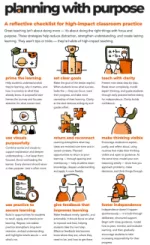There is always a risk in attempting to distil the richness of great teaching into a checklist. The work of the classroom is too complex and too contingent on context to be captured in such simple terms. We all know that what succeeds in one lesson may fall flat in another.
In the face of this complexity, many of us find it helpful to return to a set of guiding principles — not as prescriptions, but as prompts for reflection. This resource aims to bring together a small number of such principles in a form designed to support deliberate, thoughtful planning.
Prime the learning
Help students understand what they’re learning, why it matters, and how it connects to what they already know. A purposeful start frames the journey and focuses attention for what comes next.
Set clear goals
Make the goal of the lesson explicit. When students know what success looks like — they can focus, track their progress, and take more ownership of their learning. Clarity at the start reduces ambiguity and guides effort.
Teach with clarity
Present new ideas step by step. Break down complexity, model expert thinking, and guide students through early practice before asking for independence. Clarity builds confidence.
Use visuals purposefully
Combine words and visuals to support explanation and deepen understanding — but keep them focused. Avoid overloading the learner. Every element should serve a clear purpose. Less is often more.
Return and reconnect
Learning strengthens when key ideas are revisited over time and in varied contexts. Planned opportunities to return to prior learning — through spacing and interleaving — help students retain knowledge, deepen understanding, and apply it more flexibly.
Make thinking visible
Encourage students to explain, justify, and reflect aloud, using routines that make their thinking visible and open to guidance. At the same time, model your own reasoning clearly — show how you approach problems, make decisions, and think things through.
Use practice to secure learning
Build in opportunities for students to recall, apply, and rework prior learning. Regular, low-stakes practice strengthens long-term retention, embed understanding, and highlights what’s secure — and what’s not.
Give feedback that improves learning
Make feedback timely, specific, and actionable. It should focus on what to improve and how, helping students take the next step. Effective feedback lets learners know where they are, where they need to be, and how to get there.
Foster independence
Independence doesn’t happen spontaneously — it is built through deliberate, structured support. Begin with close guidance, model how to plan, monitor, and evaluate learning, and then gradually encourage students to take increasing responsibility for their progress.
This resource, which is also available as a free A4 PDF poster, is not intended as a framework or rubric, and certainly not as a means of evaluation. Rather, it is offered as a simple tool: something to keep close by, to return to, and to use as a starting point for conversation and professional reflection. It aims to be useful to teachers at any stage in their career, and adaptable to the varied contexts in which they work.

Sometimes, what is most helpful is not novelty, but clarity — a reminder of what matters, and of the everyday choices that help great teaching take root.
You can download the free one-page aid mémoire in high-res PDF format below. I hope it proves useful.
…and another thing
If you’ve found this resource useful, you might be interested in exploring the Professional Development section of this site. Alongside writing and consultancy, I also work with schools and organisations to support thoughtful, evidence-informed professional learning.
Whether it’s a workshop, a presentation, or a more sustained programme of development, I’m always happy to collaborate with colleagues looking to deepen their practice or explore new ideas together.
Get in touch for a conversation. No hard sell. Just a shared commitment to teaching that makes a difference.
References and Further Reading
Brown, P.C., Roediger III, H.L. and McDaniel, M.A., 2014. Make it Stick: The Science of Successful Learning. Cambridge, MA: Belknap Press of Harvard University Press.
Coe, R., Wiliam, D., Jones, K. and Tyler, E., 2020. Great Teaching Toolkit: Evidence Review. Cambridge: Evidence Based Education. Available at: https://evidencebased.education/great-teaching-toolkit/
Rosenshine, B., 2012. Principles of Instruction: Research-Based Strategies That All Teachers Should Know. American Educator, [online] Spring, pp.12–19. Available at: https://www.aft.org/sites/default/files/periodicals/Rosenshine.pdf
Wiliam, D., 2016. Leadership for Teacher Learning: Creating a Culture Where All Teachers Improve So That All Students Succeed. West Palm Beach, FL: Learning Sciences International.
Education Endowment Foundation (EEF), 2021. Teaching and Learning Toolkit. [online] Available at: https://educationendowmentfoundation.org.uk/education-evidence/teaching-learning-toolkit
EEF, 2018. Metacognition and Self-Regulated Learning: Guidance Report. [online] Available at: https://educationendowmentfoundation.org.uk/education-evidence/guidance-reports/metacognition
Sherrington, T., 2019. Rosenshine’s Principles in Action. Woodbridge: John Catt Educational.
“Learning that’s easy is like writing in sand, here today and gone tomorrow.”
— Brown, Roediger, & McDaniel (2014)
Subscribe to our newsletter
- Actionable insights on leadership, learning, and organisational improvement
- Thought-provoking reflections drawn from real-world experience in schools and beyond
- Curated resources on effective practice and digital strategy
- Early access to new articles, events, and consultancy updates
- Invitations to subscriber-only webinars, Q&As, and informal conversations
- Clarity, not clutter—you will not be bombarded by emails
Cancel or pause anytime.

Leave a Reply